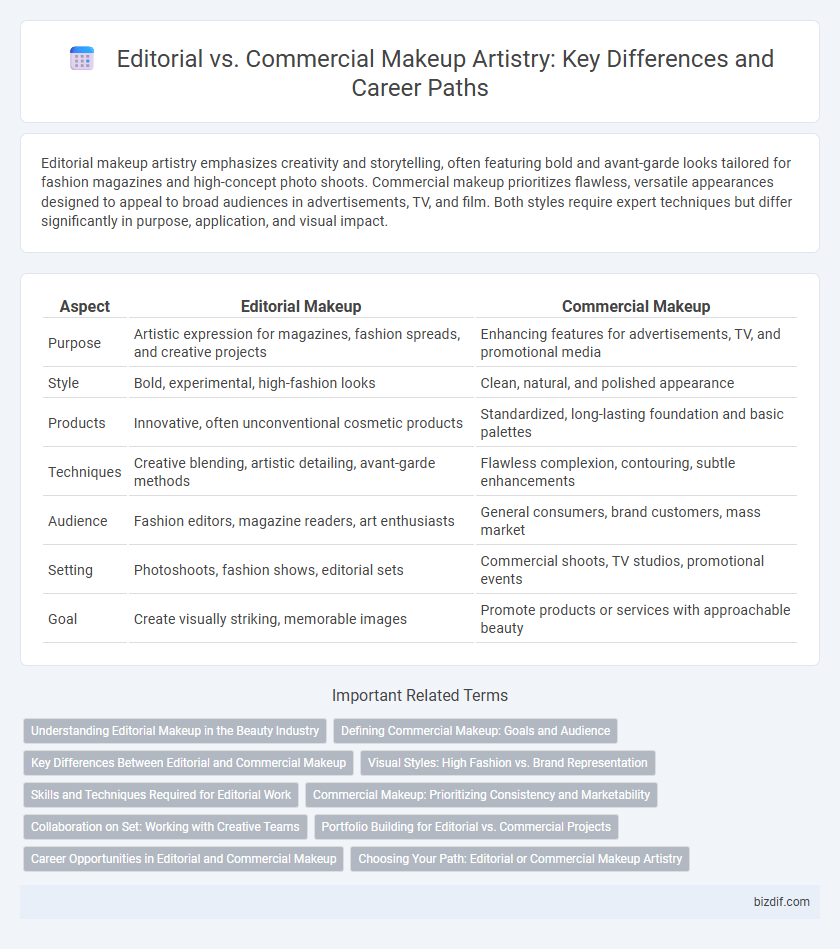Editorial makeup artistry emphasizes creativity and storytelling, often featuring bold and avant-garde looks tailored for fashion magazines and high-concept photo shoots. Commercial makeup prioritizes flawless, versatile appearances designed to appeal to broad audiences in advertisements, TV, and film. Both styles require expert techniques but differ significantly in purpose, application, and visual impact.
Table of Comparison
| Aspect | Editorial Makeup | Commercial Makeup |
|---|---|---|
| Purpose | Artistic expression for magazines, fashion spreads, and creative projects | Enhancing features for advertisements, TV, and promotional media |
| Style | Bold, experimental, high-fashion looks | Clean, natural, and polished appearance |
| Products | Innovative, often unconventional cosmetic products | Standardized, long-lasting foundation and basic palettes |
| Techniques | Creative blending, artistic detailing, avant-garde methods | Flawless complexion, contouring, subtle enhancements |
| Audience | Fashion editors, magazine readers, art enthusiasts | General consumers, brand customers, mass market |
| Setting | Photoshoots, fashion shows, editorial sets | Commercial shoots, TV studios, promotional events |
| Goal | Create visually striking, memorable images | Promote products or services with approachable beauty |
Understanding Editorial Makeup in the Beauty Industry
Editorial makeup showcases artistic creativity and storytelling through bold, avant-garde looks designed for high-fashion magazines and runway shows. It emphasizes innovation and concept-driven designs that push beauty boundaries, often using unconventional colors, textures, and techniques. This style contrasts with commercial makeup, which prioritizes polished, wearable looks aimed at mass-market advertising and product promotion.
Defining Commercial Makeup: Goals and Audience
Commercial makeup centers on enhancing a product or brand's appeal, targeting broad consumer audiences through advertisements, catalogs, and promotional materials. The primary goal is to create polished, marketable looks that highlight features while maintaining versatility and wearability across different lighting and settings. Makeup artists in commercial work prioritize consistency, brand alignment, and mass appeal to influence purchasing decisions effectively.
Key Differences Between Editorial and Commercial Makeup
Editorial makeup emphasizes artistic expression, often showcasing bold, avant-garde looks designed for high-fashion magazines and runway shows, prioritizing creativity over wearability. Commercial makeup focuses on enhancing natural beauty to appeal to a broad audience in advertisements, television, and product promotions, favoring polished and universally flattering styles. Key differences include purpose, with editorial makeup serving artistic storytelling and commercial makeup aiming for consumer relatability and marketability.
Visual Styles: High Fashion vs. Brand Representation
Editorial makeup artistry emphasizes high fashion and avant-garde visual styles that push creative boundaries to create striking, artistic images often seen in magazines. Commercial makeup focuses on brand representation by enhancing natural beauty and ensuring the look aligns with the product's identity and target audience. The distinction lies in editorial's experimental, trend-setting aesthetics versus commercial's polished, market-driven appeal.
Skills and Techniques Required for Editorial Work
Editorial makeup artistry demands advanced skills in creativity, precision, and adaptability to conceptual themes and high-fashion aesthetics. Techniques often include dramatic contouring, bold color usage, and innovative textures to complement artistic photography and storytelling. Mastery of diverse makeup styles and quick improvisation under tight deadlines are critical for editorial success.
Commercial Makeup: Prioritizing Consistency and Marketability
Commercial makeup emphasizes achieving consistent, polished looks that enhance the product or brand's marketability across various media platforms. Techniques focus on durability, skin-perfecting finishes, and adaptability to different lighting conditions to ensure flawless appearance in advertisements and promotional content. The goal centers on appealing to a broad audience while maintaining the integrity of the product's image.
Collaboration on Set: Working with Creative Teams
Editorial makeup artistry demands seamless collaboration with photographers, fashion stylists, and art directors to create visually compelling, story-driven looks for magazines and high-fashion campaigns. Commercial makeup work prioritizes aligning with brand managers, product developers, and marketing teams to ensure the makeup enhances the product's appeal and reaches target consumers effectively. Both require adaptability, clear communication, and a shared vision to execute the creative concept flawlessly on set.
Portfolio Building for Editorial vs. Commercial Projects
Editorial makeup artistry demands bold, creative styles that highlight artistic expression and storytelling, making it essential for portfolio building to showcase versatility and innovation. Commercial makeup projects focus on polished, wearable looks that appeal to broad audiences, emphasizing flawless execution and mass-market appeal in portfolios. Balancing editorial and commercial work in a portfolio demonstrates adaptability and skill, attracting diverse clients seeking both avant-garde and everyday makeup expertise.
Career Opportunities in Editorial and Commercial Makeup
Editorial makeup offers career opportunities primarily in high-fashion magazines, runway shows, and artistic photo shoots, emphasizing creative expression and trendsetting styles. Commercial makeup careers focus on advertisements, television, film, and bridal services, requiring versatility to enhance a wide range of looks that appeal to broad audiences. Professionals in editorial makeup often collaborate closely with photographers and stylists, while commercial makeup artists work extensively with clients and production teams to achieve polished, marketable results.
Choosing Your Path: Editorial or Commercial Makeup Artistry
Editorial makeup artistry emphasizes creative expression and high-fashion aesthetics for magazines, runway shows, and artistic photo shoots, prioritizing bold, trend-setting looks that captivate audiences. Commercial makeup artistry focuses on versatile, polished styles tailored for advertisements, television, and product promotions, designed to enhance natural beauty and appeal to broad consumer markets. Selecting your path depends on whether you prefer innovative, avant-garde work or practical, market-driven applications that consistently meet client needs.
Editorial vs Commercial Infographic

 bizdif.com
bizdif.com